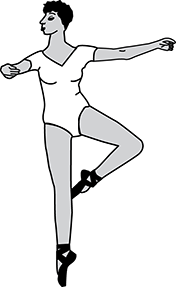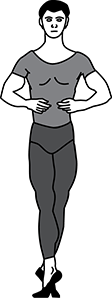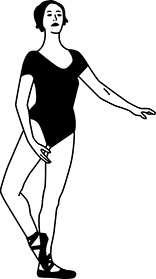Test Information Guide
Field 46: Dance
Sample Multiple-Choice Questions
Dance Movement: Elements, Skills, and Concepts
Objective 0001
Understand movement skills, elements, and concepts and their relationship to dance learning and performing.
1. A jazz dancer is performing a warm-up exercise in which he moves only his head, then only his shoulders, then only his ribcage, and so on until he has warmed up each area of his body in this way. This type of warm-up exercise is known as:
- isolation.
- ballistic.
- progression.
- static.
- Answer
- Correct Response: A.
Correct Response: A.
Objective 0002
Understand fundamental skills and concepts of diverse styles and genres of dance.
2. Which of the following illustrations shows proper placement of the feet in a cou-de-pied devant position?
- Answer
- Correct Response: D.
Correct Response: D.
Objective 0003
Understand the developmental progression of physical skills and movement technique and the importance of personal practices in learning and performing dance.
3. In dance, which of the following is a common cause of a strained knee joint?
- repeated flexing and releasing of the muscles surrounding the knee
- improperly fitting clothing and shoes
- poor alignment between the thigh and ankle
- prolonged weight distribution over a single supporting leg
- Answer
- Correct Response: C.
Correct Response: C.
Dance as Expression: Creation, Production, and Analysis
Objective 0004
Understand and apply principles and processes of choreography.
4. In dance, which of the following compositional forms consists of a basic theme that returns between sections of contrasting material?
- rondo
- canon
- collage
- AB
- Answer
- Correct Response: A.
Correct Response: A.
Objective 0005
Understand and apply principles of interpretation, analysis, and criticism of dance.
5. Three dancers are performing the same steps simultaneously. One dancer is positioned center stage right, one dancer is positioned center stage, and the other dancer is positioned center stage left. This use of balance is most likely to serve which of the following functions?
- focusing on individual interpretations of the movements
- producing an impression of stability
- establishing one dancer as dominant
- creating strong visual tension
- Answer
- Correct Response: B.
Correct Response: B.
Objective 0006
Understand the requirements of performance and fundamentals of production and staging of dance.
6. A lighting designer is preparing a lighting plot for a realistic dance. One scene includes a romantic interlude between two characters on a moonlit terrace. To establish a realistic setting, which of the following effects would be most appropriate for the designer to include?
- a blackout
- amber frosted light
- cool-colored lights
- warm-colored lights
- Answer
- Correct Response: C.
Correct Response: C.
7. A choreographer wishes to use a combination of fog and lighting to enhance the mood of a dance piece. In a professional dance company, coordinating the creation of this special effect would be the responsibility of which of the following staff members?
- stage manager
- lighting technician
- artistic director
- production manager
- Answer
- Correct Response: D.
Correct Response: D.
Dance and Society: History, Purposes, and Practice
Objective 0007
Analyze the relationship between dance and society.
8. The development of the Caribbean dance forms such as rumba, mambo, merengue, and salsa most reflects influences related to which of the following cultural developments?
- the revitalization of traditional cultural forms during the early era of independence
- the global spread of U.S. cultural ideas through television and movies
- the fusion of cultural activities by immigrants moving between Latin America and the United States
- the movement of cultural practices from Africa and Europe during the American colonial period
- Answer
- Correct Response: D.
Correct Response: D.
Objective 0008
Analyze the history and role of dance in the United States and the world.
9. Choreographer Katherine Dunham has made a major contribution to the preservation and understanding of traditional forms of dance by:
- establishing a dance company whose primary purpose was the recreation of folk and ethnic dances from around the world.
- incorporating traditional African, Caribbean, and African American dance forms into contemporary modern dance.
- bringing dance troupes from Africa and the Caribbean to perform folk and ethnic dances for audiences throughout the United States.
- documenting traditional folk and ethnic dances from around the world and analyzing thematic similarities among them.
- Answer
- Correct Response: B.
Correct Response: B.
Objective 0009
Analyze the connections between dance and other disciplines.
10. The use of dance in the study of somatics combines movement with which of the following other disciplines?
- language arts
- physics
- psychology
- mathematics
- Answer
- Correct Response: C.
Correct Response: C.




